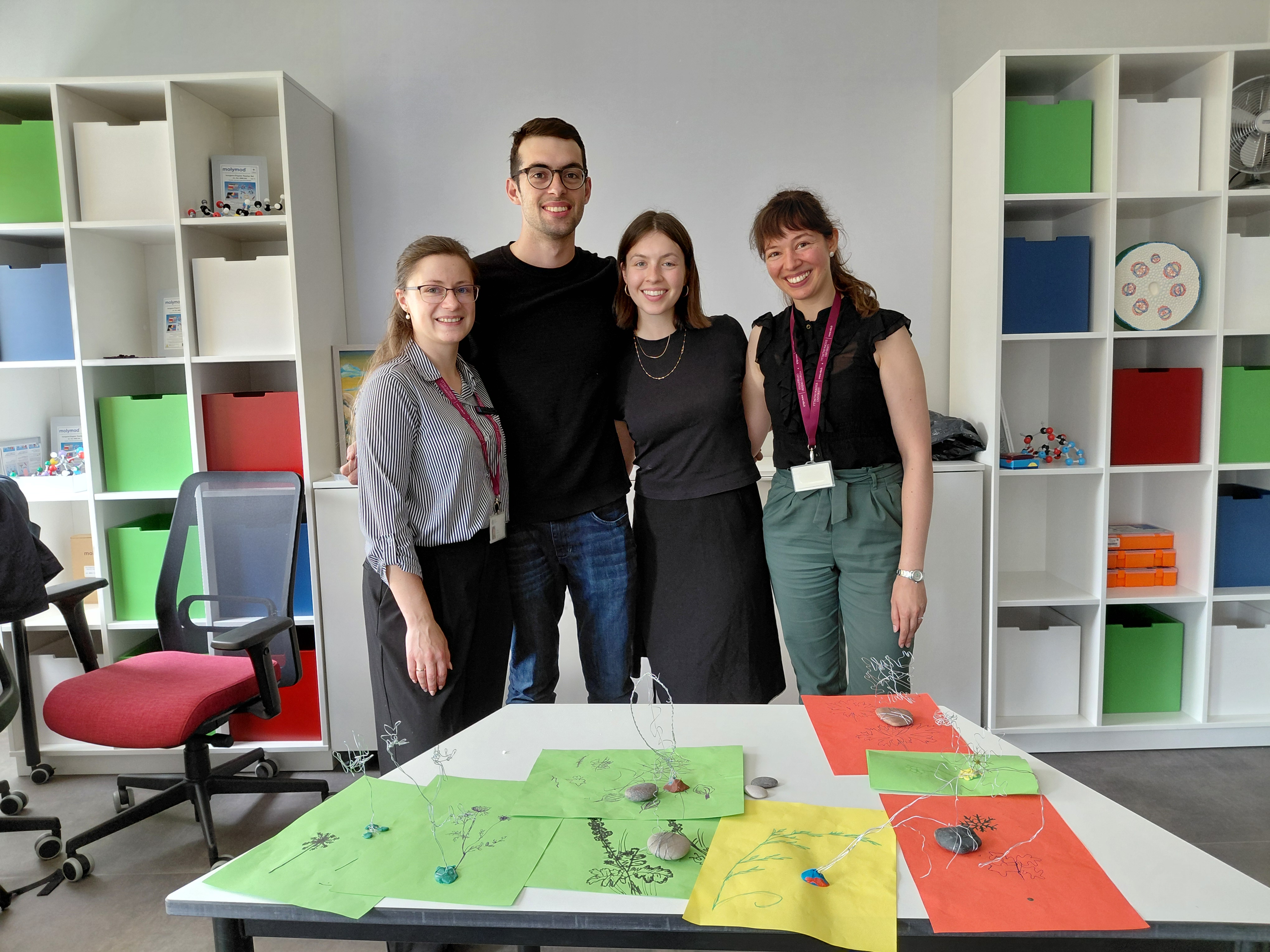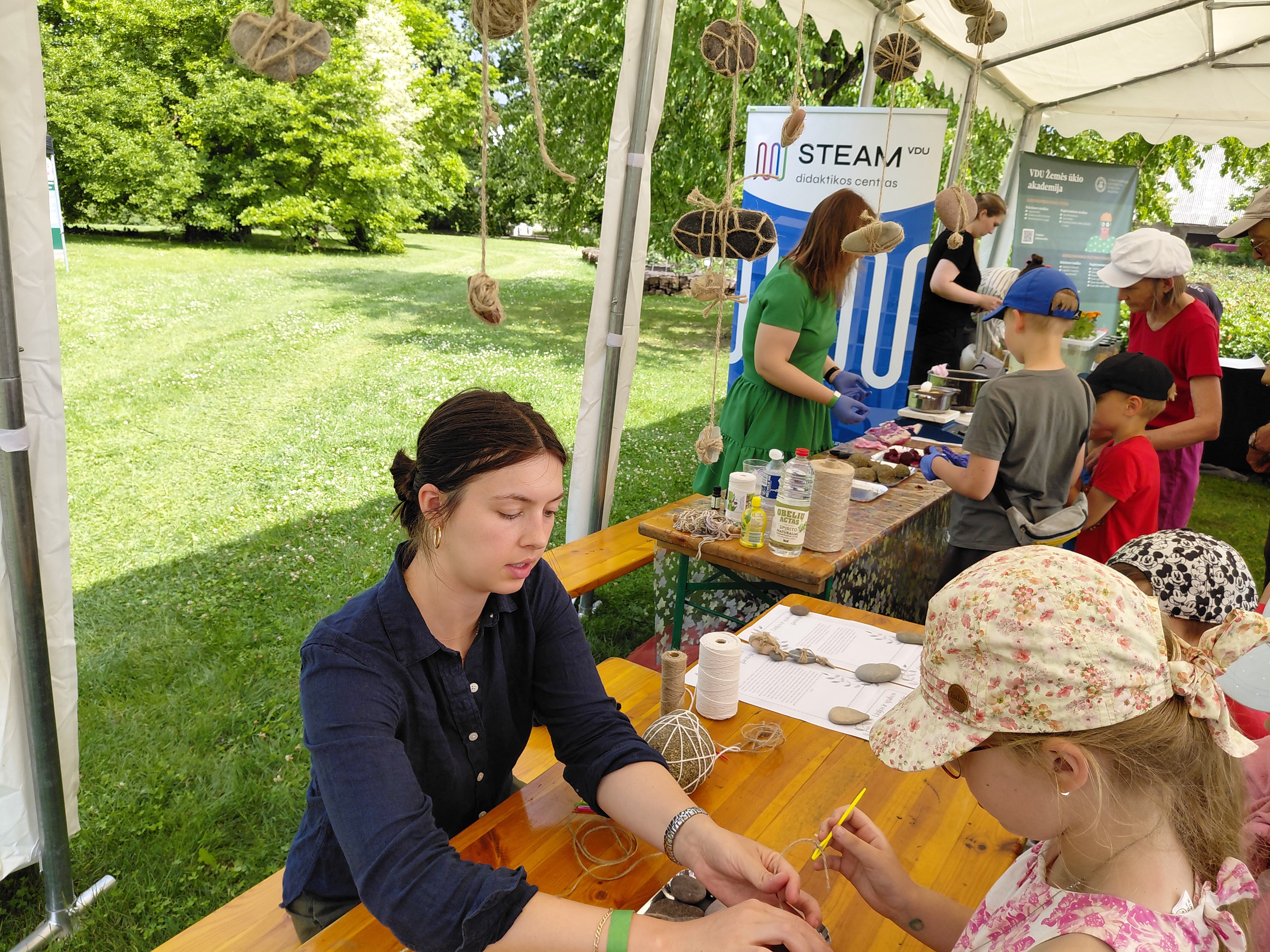MIT intern at VMU: STEAM Education Helps to Create Future Education Models

From the left: Francisco Ramirez Serrano, Coco Allred and dr. Vesta Vančugovienė, the deputy director of VMU STEAM Didactics Centre
“Art is a method of inquiry, and empathy lies at the heart of its aesthetics. When curiosity, play, and experimentation become part of the creative process, students engage differently—they discover interdisciplinary connections and new forms of collaboration,” says Coco Allred, a student at the Massachusetts Institute of Technology (MIT) who interned at the Vytautas Magnus University’s (VMU) STEAM Didactic Center this summer.
This internship is part of the cooperation between VMU, which is the coordinator of the MIT International Science and Technology Initiatives (MISTI) consortium in Lithuania.
Creativity as the scafolding of interdisciplinary bridges
Coco Allred’s practice explores the intersections of public space, aesthetics, and experimental pedagogy. With a background in sculpture, interdisciplinary programming, and intergenerational teaching, Coco designs participatory environments that activate space as a site for collective learning and resistance. Coco is currently studying at MIT, where she is receiving a masters of science in art culture and technology from the school of architecture.
“While in high school, I realized that artistic expression was the most intuitive and enjoyable way of understanding what was happening in the world around me and sparking dialogue with others. . Art is both a method of research and a means of expression. In various media, the arts have also been a favorite way to learning about various topics, from personal and historical experiences to natural phenomena,” says Coco Allred.
According to the artist, from the field of learning science, we learn that emotional and cognitive thinking are not two separate phenomena, but are interrelated. Although this perception is gradually changing to be taught in other subjects,, Coco says that artists understood this logic much earlier.
“It is precisely the nuance, relevance and personal engagement that comes from entangling emotional and cognitive thinking that makes art attractive to contemporary students. As an artist, I can combine seemingly different ideas and link them through aesthetic means—for example, during this trip to Lithuania I worked on a project that combined the history of linen, the Baltic Way, poetry, and ecology by looking at the multipe definitions of the word line. The path of creative inquiry is often unexpected. I feel grateful for the generous conversations and sharing of skills from people I met this summer in Lithuania. The research I made really is a reflection of this place and I couldn’t have made it anywhere else,” admits Coco.
STEAM education is not about finding the right answer, but learning how to iterate and collaborate through uncertainty. During her internship at the VDU STEAM Didactic Center, the interdisciplinary artist not only took an interest in and delved into the center’s activities, but also gained experience by collaborating with scientists and practitioners and jointly prepared creative workshops for middle and high school students.
As the artist herself recounts, during these workshops, she and the students chose to explore linen, a plant with deep historical, cultural, and aesthetic connections in Lithuania. The students not only drew linen plants, but also analyzed their symbolism and political and historical contexts through artistic processes. The creative works—flags embroidered with the linas plant and wrapped stones are part of an installation to be exhibited at VMU in the fall.
“During these workshops, creativity became a way to strengthen intercultural dialogue—both between Lithuania and the US, and between different disciplines. I am glad that the students created and searched for their own meanings and experimented boldly,” says the artist.
According to Coco Allred, one of the most important goals of STEAM is to develop independent thinking, take risks, and not be afraid of failure. She emphasizes that art in this context helps not only to understand the world, but also to create more ethical and inclusive communication.
I often look for intersections of topics where the process of an aesthetic investigation sparks dialogue and analysis regarding our cultural and ecological conditions. Learning to dissect these conditions is an important step in creating better conditions for ourselves and future generations. I always try to make lessons culturally relevant and tailored to the local context and the needs of the students. If I knew exactly how the seminar would go without delving into what I could expect from the participants, I would be very bored,” says Coco, adding that she participants, play an important role in shaping the outcome of our collective learning.
“I think it’s very important to have a space where people of different generations can learn, regardless of their skill level, and I’m very keen to develop programs for this purpose. One of the things that I think is not talked about enough is that this kind of work requires a lot of social and emotional intelligence from students. We need to include this in the process plan,” notes Coco, who seeks to create an environment in her workshops where the process is more important than the result, and collective intelligence is more important than individual success.
The essence of knowledge lies in the process
According to the MIT student, schoolchildren begin to identify with different disciplines at a very early age. Some consider themselves to have an artistic streak, while others are more inclined towards the technological sciences. By bringing more arts into STEAM she is trying to break those educational silos.
“We each have unique ways of learning and thinking and we need all of them. The teaching methods used in schools often reinforce this division, the approach to teaching math is often very different to art. I think that the integration of gamification to teach computer science, an early age is a great example of how educators can make their subjects accessible and engage a wider range of students in learning. Creative and divergent thinkers are usually very curious about the world, and the opportunity to better understand the impact of technology and the application of creative methods in various disciplines is a key source of motivation,” says Coco Allred.
The artist points out that when conducting creative workshops for schoolchildren, which also aim to strengthen their problem-solving and collaboration skills, she notices that moments of play and unpredictability play an increasingly important role.
000009477-rotated.jpg">000009477-rotated.jpg" alt="" width="3060" height="4080" />
“During one workshop, a student shared that through this activity, he realized that he actually knows how to draw. This is a wonderful result that reflects my desire to share drawing as a means of cognition and communication. Drawing encourages deeper observation and better thinking. Letting go of ideas about what a good drawing should look like and drawing for the process rather than the result is something I really like to emphasize in my seminars. Schools often emphasize one correct answer, but the essence of true cognition lies in the process. If students are encouraged to explore rather than just replicate, education becomes much more interesting and meaningful,” says Coco Allred.
Inspiration for the future of education
During her internship at the VMU STEAM Didactic Center, together with another MIT student, Francisco Ramirez Serrano, PhD in electrical engineering and computer science, Coco also integrated generative artificial intelligence technologies into her workshops. Students who drew the outlines of plants had the opportunity to see how their work was transformed into three-dimensional structures—wire sculptures—which helped them understand how the most advanced AI models work.
“This collaboration reveals that technology and art are not opposites – on the contrary, they complement each other and encourage us to look deeper,” says the MIT student.
Coco Allred is convinced that STEAM education should prepare young people to be creative, critical thinkers and able to collaborate in an interdisciplinary space. “Ultimately, we need students who are motivated to make the world a better place – and who have the tools to do so,” she emphasizes.
On October 9–10, the MIT MISTI Lithuanian Consortium is organizing a conference entitled “Human and More Than Human Futures: Technological Innovations for Creating Coexistence.”
Members of the Lithuanian consortium cooperating with MIT: coordinator – Vytautas Magnus University, Kaunas University of Technology, Klaipėda University, Vilnius University, Vilnius Gediminas Technical University, Vilnius Academy of Arts, Lithuanian Research Centre for Agriculture and Forestry, Lithuanian Energy Institute, Ignitis Group AB, LTG Group, Euromonitor International – Eastern Europe UAB, and Novian UAB.
The activities of the Lithuanian consortium are supported by the Lithuanian Science Council.













